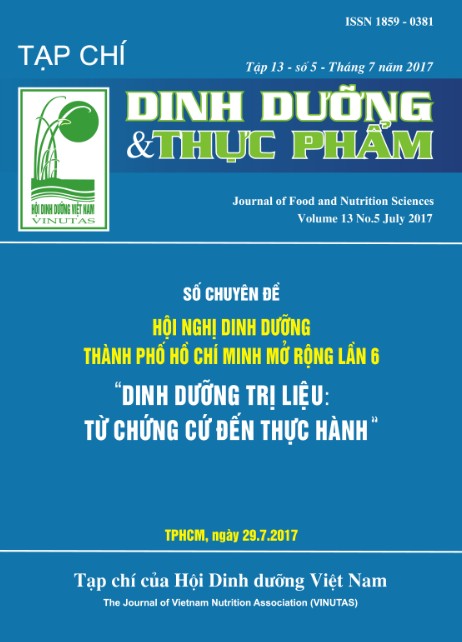VẬN ĐỘNG THỂ LỰC Ở BỆNH NHÂN ĐÁI THÁO ĐƯỜNG TÝP 2 Ở BỆNH VIỆN NGUYỄN TRI PHƯƠNG, THÀNH PHỒ HỒ CHÍ MINH
Main Article Content
Abstract
Objective: To investigate types of physical activities in type 2 diabetes mellitus outpatients at Nguyen Tri Phuong Hospital. Methods: The cross-sectional study recruited 370 subjects to be interviewed by IPAQ long form to assess the level of physical activity that were divided into four groups: physical activities at work, transportation, housework and leisure-time. Results: The percentage of intensive, moderate and low physical activities was 13 %, 51.3 % and 35.7%, respectively. The rate of subjects achieving The International Diabetes Federation (IDF) recommendations on physical activity for health was 64.9%. The average leisure time was 234.9 minutes per day. Reasons for low physical activity level among patients was not good health status (43.9%), lack of time (30.3%); and not knowing recommendation of physical activity (6.1%). There was a relationship between low physical activity and co-morbid conditions with p< 0.05. Conclusion: The rate of type 2 diabetes mellitus outpatient achieves IDF recommendation on physical activity is low. There is a relationship between lack of physical activity and co-morbid conditions. It is necessary to guide physical activity consistent with the health condition of the subjects.
Keywords
Physical activity, type 2 diabetes mellitus, Nguyen Tri Phuong Hospital, Ho Chi Minh City
Article Details
References
2. American Diabetes Association (ADA) (2015). Physical Activity is Important, http://www.diabetes.org/food-andfitness/fitness/physical-activity-is-important.html. accessed on 13/5/2016.
3. Hu G, Jousilahti P et al (2005). Physical Activity, Cardiovascular Risk Factors, and Mortality Among Finnish Adults With Diabetes. Diabetes Care, 28 (4), pp.120-128.
4. International Diabetes Federation (IDF) (2012). Global Guideline for Type 2 Diabetes. pp. 201-224.
5. Nguyễn Công Khẩn (2008). Dinh dưỡng cộng đồng và an toàn vệ sinh thực phẩm. Nhà xuất bản Giáo dục, Hà Nội, tr. 25-186.
6. NguyễnThịHồngÂn (2015). Vận động thể lực và các yếu tố liên quan ở bệnh nhân đái tháo đường type 2 khám tại bệnh viện Phú Nhuận TP.HCM năm 2015. Luận văn tốt nghiệp Cử nhân YTCC, Đại Học Y Dược TP.HCM.
7. Oyewole O.O, Odusan O. et al (2014). Physical activity among type-2 diabetic adult Nigerians. Ann Afr Med, pp. 235-244.
8. Phạm Văn Khôi (2011). Tình trạng dinh dưỡng của bệnh nhân đái tháo đường và thực trạng nuôi dưỡng, tư vấn dinh dưỡng tại Bệnh viện Bạch Mai. Luận văn Thạc sĩ, Trường Đại học Y Hà Nội.
9. Ronald T. Ackermann MD, David G.Marrero PhD (2007). Adapting the Diabetes Prevention Program Lifestyle Intervention for Delivery in the Community. The Diabetes EDUCATOR, 33 (2), pp 69-78.
10.The International Physical Activity Questionnaires (2005). Guidelines for Data Processing and Analysis of the International Physical Activity Questionnaire (IPAQ)”www.ipaq.ki.se, accessed on 12/5/2016.
11.World Health Organization Expert Consultation (2004). Appropriate body-mass index for Asian populations and its implications for policy and intervention strategies. Lancet, 363 (9403), pp. 157-163


